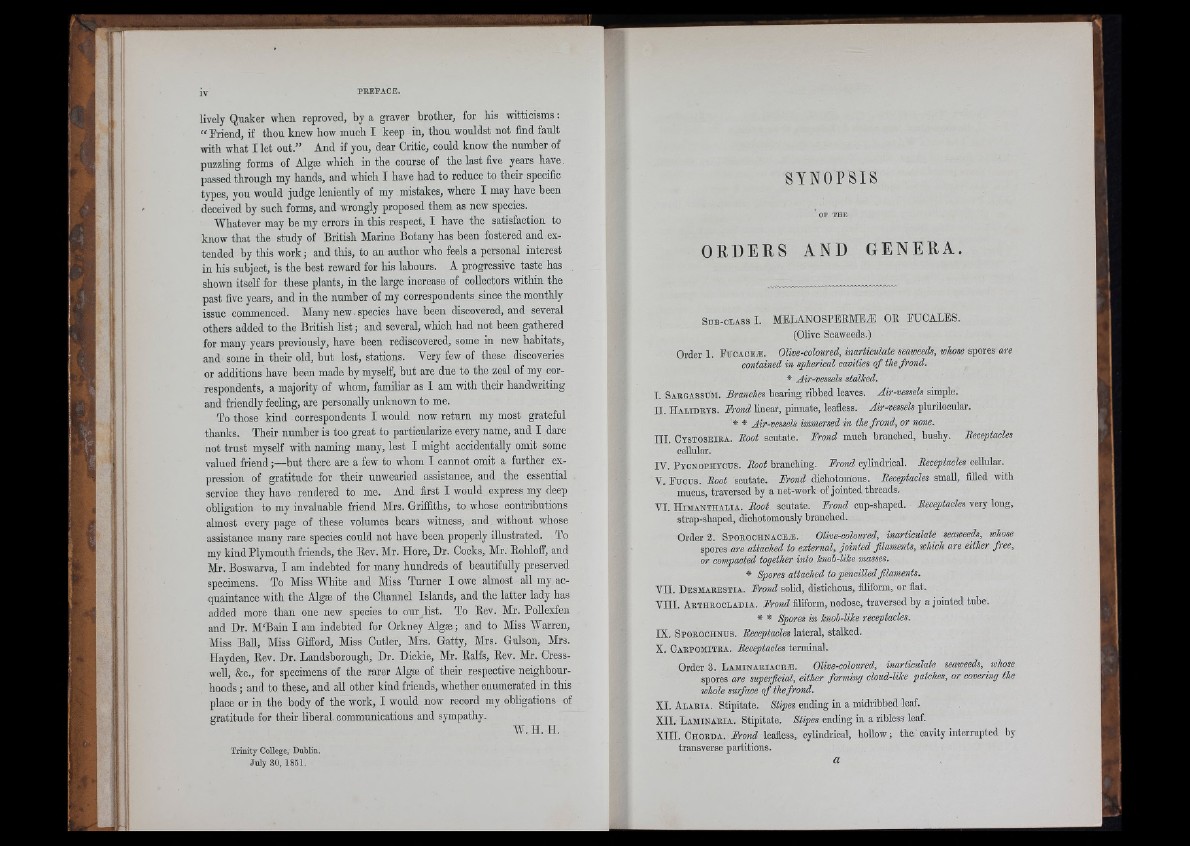
fi ,
;r i:
.-I :• ' i
■
lively Quaker when reproved, by a graver brother, for liis wittic isms:
“ Priend, if thou knew how much I keep in, th o u wouldst not find fault
with what I let out.” And if you, dear Critic, could know the number of
puzzling forms of Algm which in the course of th e last five years have,
passed through my hands, and which I have had to reduce to their specific
types, you would judge leniently of my mistakes, where I may have been
deceived by such forms, and wrongly proposed them as new species.
Wliatever may be my errors in this respect, I have the satisfaction to
know th a t the study of British Marine Botany has been fostered and extended
by this w o rk ; and this, to an author who feels a personal interest
in his subject, is the best reward for his labours. A progressive taste has
shown itseK for these plants, in the large increase of collectors within the
past five years, and in th e number of my correspondents since the monthly
issue commenced. Many new. species have been discovered, and several
others added to the British l i s t ; and several, which had not been gathered
for many years previously, have been rediscovered, some in new habitats,
and some in their old, b u t lost, stations. Yery few of these discoveries
or additions have been made by myseH, b u t are due to th e zeal of my correspondents,
a majority of whom, familiar as I am with their handwriting
and friendly feeling, are personally unknown to me.
To those kind correspondents I would now re tu rn my most grateful
thanks. Their number is too great to particularize every name, and I dare
n ot tru s t myself with naming many, lest I might accidentally omit some
valued frien d ;—b u t there are a few to whom I cannot omit a further expression
of gratitude for their unwearied assistance, and th e essential
service they have rendered to me. And first I would express my deep
obligation to my invaluable friend Mrs. Griffiths, to whose contributions
almost every page of these volumes bears witness, and without whose
assistance many rare species could not have been properly illustrated. To
my kind P lymouth friends, th e Bev. Mr. Hore, Dr. Cocks, Mr. Eoliloff, and
Mr. Boswarva, I am indebted for many hundreds of beautifully preserved
specimens. To Miss W h ite and Miss Turner I owe almost all my acquaintance
with the Algie of th e Channel Islands, and th e latte r lady has
added more th an one new species to our list. To Eev. Mr. Pollexfen
and Dr. M'Bain I am indebted for Orkney Algm; and to Miss Warren,
Miss Ball, Miss Gifford, Miss Cutler, Mrs. Gatty, Mrs. Gulson, Mrs.
Hayden, Eev. Dr. Landsborough, Dr. Dickie, Mr. EaKs, Eev. Mr. Cress-
well, &c., for specimens of th e rare r Algse of their respective neighbourhoods
; and to these, and all other kind friends, whether enumerated in this
place or in th e body of the work, I would now record my obligations of
g ra titu d e for their liberal communications and sympathy.
W . H . H.
Trinity College, Dublin.
July 30, 1851.
SYNOPS I S
ORDERS AND GENERA
Sub-class I. M E LA N O S P E EM E J ) OE EUCALES.
(Olive Seaweeds.)
Order 1. EuoacBjE. Olive-coloured, inarticulate seaweeds, whose spores are
contained in spherical cavities o f the frond.
I. Sab g a ssum . Branches bearing ribbed leaves. Air-vessels simple.
I I . IlALinBYS. Irond linear, pinnate, leafless. Air-vessels plurilocnlar.
* * Air-vessels immersed in the frond, or none.
I II. C y s to s b ib a . Boot scutate. Irond much branched, bushy. Beceptacles
cellular.
IV. P y o n o p h y o u s . Boot branching. Irond cylindrical. Beceptacles cellular.
V. E u c u s . Boot scutate. Irond dichotomous. Beceptacles small, filled with
mucus, traversed by a net-work of jointed threads.
YI. H im a n tu a l i a . Boot scutate. Irond cup-shaped. Beceptacles very long,
strap-shaped, dichotomously branched.
Order 2. S pO B O CH N A O E iE . Olive-coloured, inarticulate seaweeds, whose
spores are attached to external, jointed filaments, which are either free,
or compacted together into knoh-like masses.
* Spores attached to pencilled filaments.
VII. D e sm a e e s tia . Irond solid, distichous, filiform, or flat.
Y III . A b th e o c l a d i a . Irond filiform, nodose, traversed by a jointed tube.
* * Spores in knob-like receptacles.
IX. S p o b o c h n u s . Beceptacles lateral, stalked.
X. C ab p om itb a . Beceptacles terminal.
Order 3. LAMINABIACEJ3. Olive-coloured, inarticulate seaweeds, whose
spores are superficial, either forming cloud-like patches, or covering the
whole surface of the frond.
XI. A l a b ia . Stipitate. Stipes ending in a midribbed leaf.
XII. L am in a b ia . Stipitate. Stipes ending in a ribless leaf.
XIII. C h o b d a . Irond leafless, cylindrical, hollow; the cavity interrupted by
transverse partitions.
a